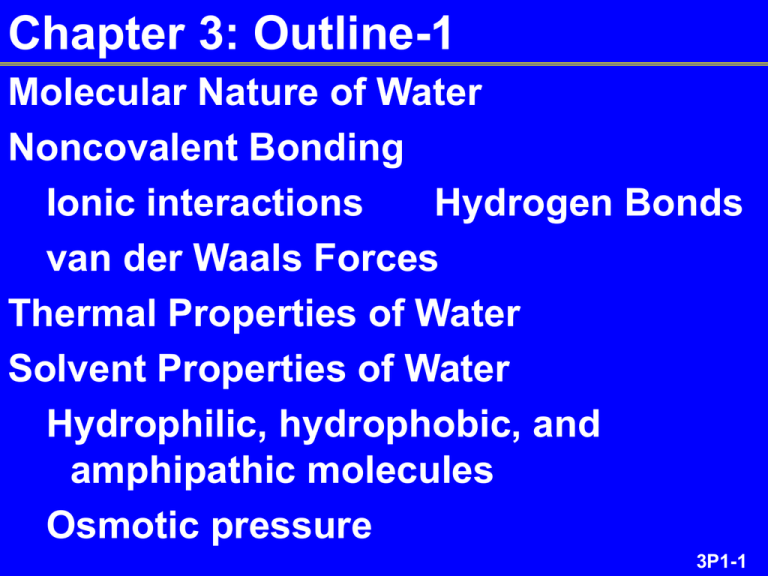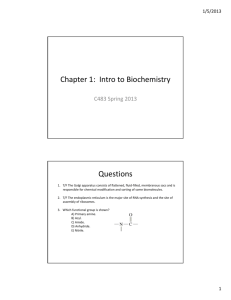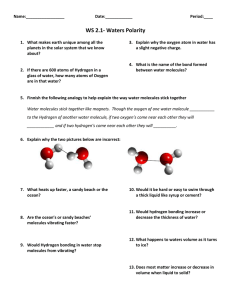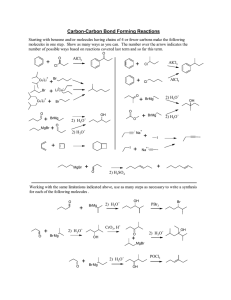Chapter 3: Outline-1
advertisement

Chapter 3: Outline-1 Molecular Nature of Water Noncovalent Bonding Ionic interactions Hydrogen Bonds van der Waals Forces Thermal Properties of Water Solvent Properties of Water Hydrophilic, hydrophobic, and amphipathic molecules Osmotic pressure 3P1-1 Chapter 3: Outline-2 Ionization of Water Acids, bases, and pH Buffers Physiological buffers 3P1-2 Water Solvent for all chemical reactions. Transports chemicals from place to place. Helps to maintain constant body temperature. Part of digestive fluids. Dissolves excretion products. 3P1-3 3.1 Molecular Structure of Water The oxygen in water is sp3 hybridized. Hydrogens are bonded to two of the orbitals. Consequently the water molecule is bent. The H-O-H angle is 104.5o. 3P1-4 Water Water is a polar molecule. A polar molecule is one in which one end is partially positive and the other partially negative. This polarity results from unequal sharing of electrons in the bonds and the specific geometry of the molecule. 3P1-5 Water Water molecule with bond ( ( ) dipoles. ) and net d- H d+ O Hd+ 3P1-6 Water Water has an abnormally high boiling point due to intermolecular d H hydrogen bonding. d O dH d O H d H d H bonding is a weak attraction between an electronegative d H atom in one molecule and an H O d H (on an O or N) in d another. 3P1-7 3.2 Noncovalent Bonding Ionic interactions Hydrogen bonding Van der Waals forces Dipole-dipole Dipole-induced dipole Induced dipole-induced dipole 3P1-8 Typical “Bond” Strengths Type kJ/mol Covalent >210 Noncovalent Ionic interactions 4-80 Hydrogen bonds 12-30 van der Waals 0.3-9 Hydrophobic interactions 3-12 3P1-9 Ionic Interactions Ionic interactions occur between charged atoms or groups. In proteins, side chains sometimes form ionic salt bridges, particularly in the absence of water which normally hydrates ions. - CH2CH2COO Salt bridge + H3N CH2CH2 3P1-10 Hydrogen Bonding Water molecules hydrogen bond with one another. Four hydrogen bonding attractions are possible per molecule: H two through the H O O hydrogens and two H H through the O nonbonding H H H H electron pairs. O H O H 3P1-11 Van der Waals Attractions a. Dipole-dipole b. Dipole-induced dipole c. Induced dipole-induced dipole d+ C d- O d+ C d- O d+ d+ d+ C d- H H d+ O H H H H H H d- H H H d- H d3P1-12 Hydrophobic interactions Nonpolar molecules tend to coalesce into droplets in water. The repulsions between the water molecules and the nonpolar molecules cause this phenomenon. The water molecules form a “cage” around the small hydrophobic droplets. 3P1-13 3.3 Thermal Properties Hydrogen bonding keeps water in the liquid phase between 0 oC and 100 oC. Liquid water has a high: Heat of vaporization-energy to vaporize one mole of liquid at 1 atm Heat capacity-energy to change the temperataure by 1 oC Water plays an important role in thermal regulation in living organisms. 3P1-14 3.4 Water-solvent Properties Water dissolves chemicals that have an affinity for it, ie. hydrophilic (water loving) materials. -many ionic compounds -polar organic compounds These compounds are soluble in water due to three kinds of noncovalent interactions: 1. ion-dipole 2. dipole-dipole 3. hydrogen bonding 3P1-15 Ion-dipole Interactions Ions are hydrated by water molecules. The water molecules orient so the opposite charge end points to the ion to partially neutralize charge. The shell of water molecules is a solvation sphere. H H O O H H H O K+ O H H O H H H O H - H Cl H H H O H O 3P1-16 Dipole-dipole Interactions The polar water molecule interacts with an O or N or an H on an O or N on an organic molecule. H O O d- H O H H3C H C d+ O CH3 H H Dipole-dipole interactions 3P1-17 Hydrogen Bonding A hydrogen attached to an O or N becomes very polarized and highly partial plus. This partial positive charge interacts with the nonbonding electrons on another O or N giving rise to the very powerful hydrogen O bond. H H hydrogen bond shown in yellow R1 O H H O H 3P1-18 Nonpolar Molecules Nonpolar molecules have no polar bonds or the bond dipoles cancel due to molecular geometry. These molecules do not form good attractions with the water molecule. They are insoluble and are said to be hydrophobic (water hating). eg.: CH3CH2CH2CH2CH2CH3, hexane 3P1-19 Nonpolar Molecules-2 Water forms hydrogen-bonded cagelike structures around hydrophobic molecules, forcing them out of solution. 3P1-20 Amphipathic Molecules Amphipathic molecules contain both polar and nonpolar groups. Ionized fatty acids are amphipathic. The carboxylate group is water soluble and the long carbon chain is not. Amphipathic molecules tend to form micelles, colloidal aggregates with the charged “head” facing outward to the water and the nonpolar “tail” part inside. 3P1-21 A Micelle 3P1-22 Osmotic Pressure-2 Osmosis is a spontaneous process in which solvent molecules pass through a semipermeable membrane from a solution of lower solute concentration to a solution of higher solute concentration. Osmotic pressure is the pressure required to stop osmosis. 3P1-23 Osmotic Pressure-3 Osmotic pressure (p) is measured in an osmometer. 3P1-24 Osmotic Pressure-4 p = iMRT i = van’t Hoff factor (% as ions) M = molarity (mol/L for dilute solns) R = 0.082 L atm/ mol K T = Kelvin temperature 1 M NaCl is 90% ionized and 10% ion pairs. i = 0.9 + 0.9 + 0.1 = 1.9 Osmolarity (osm/L) = iM 3P1-25 Osmotic Pressure-5 Because cells have a higher ion concentration than the surrounding fluids, they tend to pick up water through the semipermeable cell membrane. The cell is said to be hypertonic relative to the surrounding fluid and will burst (hemolyze) if osomotic control is not effected. 3P1-26 Osmotic Pressure-6 Cells placed in a hypotonic solution will lose water and shrink (crenate). If cells are placed in an isotonic solution (conc same on both sides of membrane) there is no net passage of water. 3P1-27 3.5 Ionization of Water Water dissociates. (self-ionizes) H2O + H2O = Ka = + H3O + OH + [H3O ][OH ] 2 [H2O] 2 + Kw = Ka [H2O] = [H3O ][OH ] 3P1-28 Water Ionization-2 The conditions for the water dissociation equilibrium must o hold under all situations at 25 . + -14 Kw= [H3O ][OH ]=1 x 10 In neutral water, + -7 [H3O ] = [OH ] = 1 x 10 M 3P1-29 Water: A/B Properties When external acids or bases are added to water, the ion product + ([H3O ][OH ] ) must equal Kw. The effect of added acids or bases is best understood using the Lowry-Bronsted theory of acids and bases. 3P1-30 Water: A/B Properties-2 Lowry-Bronsted acid = proton donor + HA + H2O = H3O + A A B CA CB C: conjugate (product) A/B 3P1-31 Water: A/B Properties-3 Lowry-Bronsted base = proton acceptor RNH2 + H2O = B A OH + RNH3 CB + CA 3P1-32 Measuring Acidity Added acids increase the concentration of hydronium ion and bases the concentration of hydroxide ion. + -7 In acid solutions [H3O ] > 1 x 10 M -7 [OH ] < 1 x 10 M -7 In basic solutions [OH ] > 1 x 10 M + -7 [H3O ] < 1 x 10 M pH scale measures acidity without using exponential numbers. 3P1-33 pH Scale + Define: pH = -log(10)[H3O ] 0---------------7---------------14 acidic basic + -7 [H3O ]=1 x 10 M, pH = ? 7.0 3P1-34 pH Scale-2 + -5 [H3O ]=1 x 10 M, pH = ? 5 (acidic) + -10 [H3O ]=1 x 10 M, pH = ? 10 (basic) What if preexponential number is not 1? 3P1-35 pH Scale-3 + -5 [H3O ]=2.6 x 10 M, pH = ? 4.59 (acidic) + -9 [H3O ]=6.3 x 10 M, pH = ? 8.20 (basic) + -3 [H3O ]=7.8 x 10 M, pH = ? 2.11 (acidic) 3P1-36 pH Scale-4 + O ]? pH to [H3 inverse log of negative pH orange juice, pH 3.5. [H3 + O] = 3.2 x + [H3O ]=? -4 10 M urine, pH 6.2. [H3O+]=? [H3 + O] = 6.3 x -7 10 M 3P1-37 Strength of Acids Strength of an acid is measured by the percent which reacts with water to form hydronium ions. Strong acids (and bases) ionize close to 100%. eg. HCl, HBr, HNO3, H2SO4 3P1-38 Strength of Acids-2 Weak acids (or bases) ionize typically in the 1-5% range . eg. CH3COCOOH, pyruvic acid CH3CHOHCOOH, lactic acid CH3COOH, acetic acid 3P1-39 Strength of Acids-3 Strength of an acid is also measured by its Ka or pKa values. HA + H2O = + H3O + A Ka = [H3O+][A-] [HA] Larger Ka and smaller pKa values indicate stronger acids. 3P1-40 Strength of Acids-4 Ka pKa -3 CH3COCOOH 3.2x10 2.5 -4 CH3CHOHCOOH 1.4x10 3.9 -5 CH3COOH 1.8x10 4.8 Larger Ka and smaller pKa values indicate stronger acids. 3P1-41





